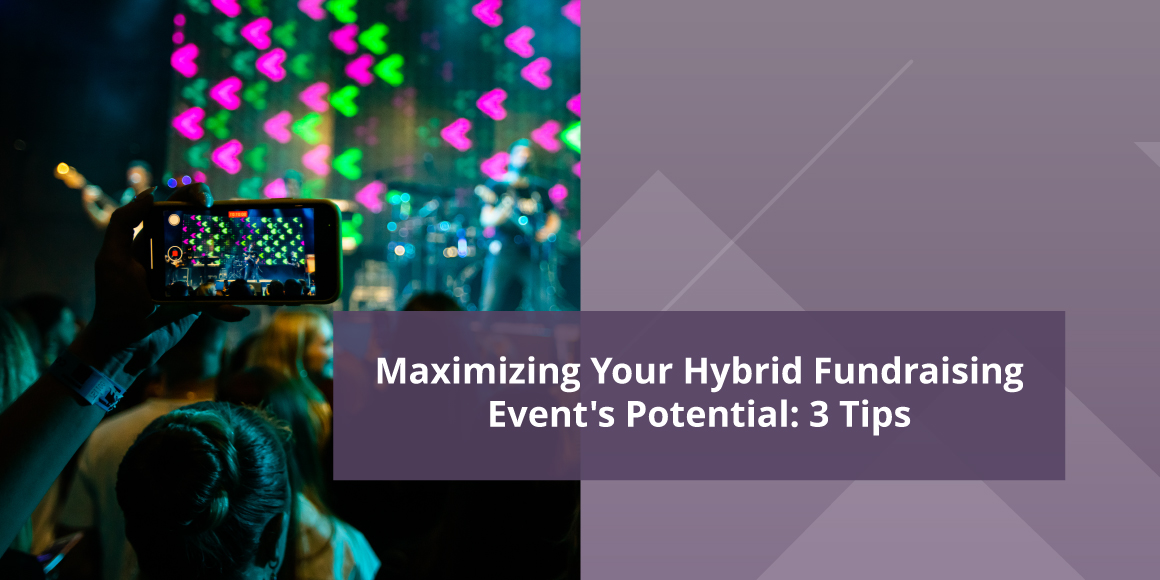With the advancement of technology, nonprofit organizations have gradually learned that they can maximize their fundraising revenue by hosting hybrid fundraising events. These events combine the best aspects of in-person and virtual events, allowing you to better engage attendees and supporters from all over the world.
If you’ve already hosted a hybrid event or two, you’re likely looking for ways to improve future events and maximize their fundraising potential. Plus, you’re probably searching for solutions to address any challenges you faced at your previous events.
We’ll help with your event planning process by covering three tips to create a more impactful hybrid fundraising event experience. By implementing these tips, you’ll not only be able to increase the funds you receive from your hybrid events, but you’ll also create a more memorable experience for attendees.
1. Strategically select a type of hybrid event to host.
There are many different types of in-person fundraising event ideas floating out there, and it’s no different for hybrid events. In fact, with a little creativity, you can adapt almost any type of fundraising event to fit a hybrid format.
But it’s still important to choose strategically! Swaim Strategies recommends hosting these four hybrid event types:
- Studio audience. This type of event is best for a small group of people. Invite key donors to an in-person gathering for a live broadcast of your program, giving them an intimate, behind-the-scenes experience. Other supporters can watch the broadcast online through your livestream. This event provides key supporters with a special experience without incurring the costs of producing a larger event.
- Screening. Visiting a movie theater to watch a new film is a fond memory for many people. Tap into those positive feelings with a hybrid screening of a video telling your nonprofit’s story, complete with a big screen and theater-style seating. This event is cost-effective, easily scalable, and can be as casual or formal as you want.
- Hybrid gala. Historically, fundraising events were designed for major donors, and the gala is a testament to that. Many larger nonprofits host an annual gala for key donors to provide a night of glitz, glam, and entertainment. Make your black-tie events accessible to all donors by livestreaming the event for smaller donors and supporters, fostering a sense of community and inclusion.
- Watch party. Engage supporters with your mission by inviting them to host a watch party on your behalf. During a watch party event, supporters such as board members or donors gather their friends together to watch your nonprofit’s online broadcast. These events are a great option for organizations that want to include supporters from all over the world.
If you haven’t hosted one of these types of hybrid fundraising events, try one for a memorable and community-building experience. To boost attendance and engagement, consider what events your nonprofit’s supporters usually enjoy and start there.
2. Create a sponsorship solicitation strategy.
Instead of relying on small donations from individual donors to fulfill your hybrid event’s fundraising goals, consider reaching out to major donors and sponsors to supplement your funding. Since it’s slightly more challenging to keep virtual attendees engaged during a hybrid event, this is a great way to ensure your event is a success.
When it comes to recruiting your hybrid event’s sponsors, follow these steps:
- Create sponsorship levels. Before you research or contact sponsor prospects, create a list of different sponsorship levels to choose from. Each level should clearly outline your financial expectations of the sponsor. For example, your lowest sponsorship level might request $1,000, whereas your highest might be $20,000. Determine upfront what combination of levels will meet your sponsorship goals for your fundraising event.
- Establish sponsor benefits. In addition to your sponsorship levels, establish clear benefits for your sponsors depending on the amount they contribute to your event. For low-level sponsors, you might simply include their logo on your event landing page. For the highest-level sponsors, you might include their branding on all your marketing materials in addition to featuring them in a social media post and thanking them in your event’s closing remarks.
- Identify prospects. From previous events, you likely already have a good idea of which major donors or businesses would be interested in sponsoring your nonprofit’s hybrid event. On top of those prospects, consider local businesses, companies that work in a similar industry, and mid-sized donors with the financial capacity to make a major gift.
- Research prospects thoroughly. After you’ve identified your prospects, research each of them thoroughly. Dig into their giving history, learn about their interests, and evaluate their financial capacity to give. If they’re a business, you can also examine their core values, philanthropic initiatives, and sponsorship guidelines, if they have any.
- Create a sponsorship proposal. With the information from the previous four steps, put together a sponsorship proposal template. Outline all relevant information, including details of your event, your expectations for your sponsors, and the benefits they’ll receive. Then, personalize proposals for each unique sponsor prospect.
After you’ve completed these steps, you’re ready to reach out and schedule meetings with potential sponsors. Remember that your prospects are probably very busy, so keep your meeting short and sweet. If faced with rejection, handle it gracefully—after all, a sponsorship refusal is not a burnt bridge, and the donor or business may be open to the idea in the future.
3. Invest in reliable virtual event platforms.
As mentioned earlier, you might have encountered obstacles to hosting hybrid fundraising events in the past. One of the greatest challenges that nonprofit professionals face with hybrid fundraising events is technology.
If you’re unfamiliar with the livestreaming platform you’re using, for example, then you’ll find it difficult to troubleshoot any issues that arise during the event. To prevent that from happening, be sure to invest in reliable virtual event software. Before purchasing, explore the tool’s reviews on websites such as G2 and Capterra. Be sure to check the customer support offered—ideally, they should be available 24/7 via email and phone for no extra fee. Don’t be afraid to schedule a demo with a customer service representative to ask all your questions and see the tool in action.
Furthermore, be sure to only invest in the software necessary for your hybrid event. For example, Handbid recommends mobile bidding tools for hybrid silent auctions, but this type of solution is not necessary for other types of hybrid events. Think carefully about what features you need to simplify your event process to ensure that you don’t overpay for tools that aren’t necessary. And, if you need help determining which solutions are the best for your nonprofit’s event, consider speaking to an event consultant for their expert advice.
Aside from these three tips, be sure to follow other fundraising event best practices for your hybrid event, such as marketing your fundraiser through multiple channels. By doing so, you can plan and create a solid hybrid fundraising event that builds community and generates funds, allowing your nonprofit to further work toward its mission.





Doppelstab
The emphasis on creating a seamless experience for both virtual and in-person attendees is spot-on. The tips on leveraging technology to engage remote participants and fostering a sense of community are particularly insightful. The suggestion to incorporate interactive elements and live-streamed content adds a dynamic touch to fundraising events, ensuring they remain engaging and impactful.